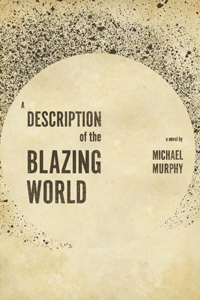Reviews
Fiction Review by Harold Hoefle
Michael Murphy, A Description of the Blazing World (Calgary: Freehand, 2011). Paperbound, 234 pp., $21.95.
The title of this book may sound like a promise of something external, some place of arcing missiles and exploding buildings, a literary version of Libya. Nope. The blazing happens within. It happens inside the novel’s dual protagonists—an unnamed boy and a young man named Morgan Wells—and what crackles, flames, and refuses to quiet is their respective memories of loss. Ousted by his wife, the boy’s father has disappeared; also, Morgan’s wife has left him, not long after their newborn died in hospital. In chapters that switch between the boy’s and Morgan’s narratives, debut novelist Michael Murphy tracks the trajectory of male sufferance; of the tension between a past that cannot be controlled, and a present that can. Take one’s own death, for example; when overwhelmed by memory, or by the present moment, why not escape into immediate demise? This option is sometimes chosen by Murphy’s fourteen-year-old narrator, and the reader sees this choice on page one: “I’ve been shot ninety times. The man holds the gun. Then puts a bullet in my gut. My temple. My solar plexus. Right between the eyes. It’s happened eight times on the sidewalk, thirteen times at school, twenty-two times in a convenience store, a place with scummy tile floors and”—the details accrue. Imagining your own death is one way of escaping pain; another is coincidence. Who else has your name? Find someone in your town who does; find out where this person lives; start to stalk them. That’s the escape method chosen by Morgan Wells.
Murphy is good at the double-stranded plot, a structural doubling that literally embodies the entire novel’s thematic twinning. Both narrative strands unspool in early-millennium Toronto. The boy-narrator is sent there by his mother and stepfather from their home in “Nowhereville, N.S.” The boy will stay with his older brother Dave, he of “the headlock look, the death glare,” in an apartment that smells “like stinky sleeping bags.” Dave lives with his Mexican wife and her (not his) young son. Our narrator deals with the ever-present threat of boredom by recording conversations (usually secretly) on something his beloved foreign-correspondent father left behind two years previously: a Sony BM-610 Minicassette Dictator. Boredom, though, takes a hit when a blackout engulfs Toronto; also, ironically, on that day the boy finds a book while searching for candles: Margaret Cavendish’s The Description of a New World, Called the Blazing World. This science-fiction novel (one of the first) was first published in 1666. Our curious boy-narrator reads the flyleaf inscription, written by a woman named Myrna: “Don’t lose this,” she commands the recipient, and signs off “with love.” There is an address—yes! The boy is off, walking the city in search of the book’s origin, while he convinces himself that the book and blackout foretell the end of the world. Murphy reveals these boy-narrative details early in the novel; meanwhile, the parallel plot is activated by the arrival in Morgan Wells’s apartment of a postcard from Paris, a card addressed to another Morgan Wells (the address is smudged; a similar road name is near). As our protagonist decides to discover where the other Morgan Wellses of the city live, he too begins to wander the streets. A blackout, a discovered sci-fi novel, and a misdirected postcard are Murphy’s plot catalysts, and the distractions his protagonists use to escape loss and despair. The boy and Morgan obey the dictum of English writer Norman Douglas: “Externalize yourself!” However, as Murphy makes clear, that’s not so easy.
For all the adolescent highjinks, exuberance of language—the boy’s brother is “a ramrodded fuckerhead”—and pure physical movement, Murphy’s novel is very much about being haunted, and what that haunting does to you on the inside and outside. Yes, Morgan Wells often and comically adds to a mental list of his ex-wife’s faults —“10. Hates raspberries…59. Never sits in the aisle seat”—but that is playful maligning compared to a recurrent memory of “the hospital with its squeaky white corridors standing above an isolette on no sleep while his wife made plans for her departure while tiny lungs collapsed on an unformed heart while bags of fluids and oxygen pumps worked uselessly to”—and you get the idea. Images appear like unbidden ghosts
in the brain of Murphy’s protagonists. Those ghosts sometimes compel Morgan to pop antacid pills, to stare out a window on a rainy day and count umbrellas. Both he and the boy need to control what they see and, with hope, what they feel.
Apart from Murphy’s plot acrobatics and insights into loss, there is a lot of solid imagistic writing in A Description of the Blazing World. Now, if he was my friend and had shown me his manuscript before he sent it to the publisher, I’d have emailed him thus: “MM: good job on the novel. Like the doubling especially. One small ‘but’—cut the first three words of your title; you don’t need them. Best, HH.”
—Harold Hoefle









